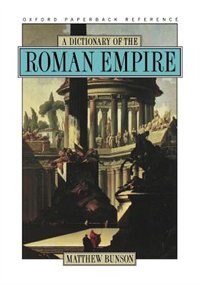Home
A Dictionary of the Roman Empire by Matthew Bunson, Paperback | Indigo Chapters
Loading Inventory...
Coles
A Dictionary of the Roman Empire by Matthew Bunson, Paperback | Indigo Chapters
From Matthew Bunson
Current price: $60.50


Coles
A Dictionary of the Roman Empire by Matthew Bunson, Paperback | Indigo Chapters
From Matthew Bunson
Current price: $60.50
Loading Inventory...
Size: 3.3 x 17.8 x 870
*Product information may vary - to confirm product availability, pricing, shipping and return information please contact Coles
The extraordinarily rich cultural legacy of the Roman world has had a profound affect world civilization. Roman achievements in architecture, law, politics, literature, war, and philosophy serve as the foundation of modern Western society. Now, for the first time in an A-Z format, A Dictionaryof the Roman Empire assembles the people, places, events, and ideas of this remarkable period in one easy-to-use source. With over 1, 900 entries covering more than five hundred years of Roman history, from Julius Caesar and the Gallic Wars (59-51 B. C.) to the fall of Romulus Augustus, the last Romanemperor (476 A. D.), this accessible guide provides quick reference to one of the most studied periods of all antiquity. Every aspect of Roman life is included. Here are profiles of the great emperors, such as Marcus Aurelius, one of the most profoundly intellectual monarchs in western civilization, and the aberrant Gaius Caligula, who, after draining the Roman treasury with his eccentric behavior, made it acapital crime for citizens not to bequeath him their estates. Informative entries describe the complex workings of Roman government, such as census taking, the creation of civil service, coinage, and the venerable institution of the Senate, and offer insight into the various trends and culturaltastes that developed throughout Roman history. For example, a discussion on baths, the most common type of building in the Roman Empire, demonstrates the unique intermingling of luxury, community, recreation, and, in the provinces, an association with Rome, that served as the focus of any cityaspiring to greatness. Other entries describe the practice of paganism, marriage and divorce, ludi (public games held to entertain the Roman populace), festivals of the Roman year, and gluttony (epitomized by famous gourmands such as the emperor Vitellius, who according to the historian Suetonius, lived for food, banqueting three or four times a day, routinely vomiting up his meal and starting over). Also featured are longer essays on such topics as art and architecture, gods and goddesses, and the military, as well as a chronology, a short glossary of Roman terms, and appendices listing theemperors of the Empire and diagram the often intertwined family trees of ruling dynasties. Comprehensive, authoritative, and illustrated with over sixty illustrations and maps, A Dictionary of the Roman Empire provides easy access to the remarkable civilization upon which Western society was built. | A Dictionary of the Roman Empire by Matthew Bunson, Paperback | Indigo Chapters








